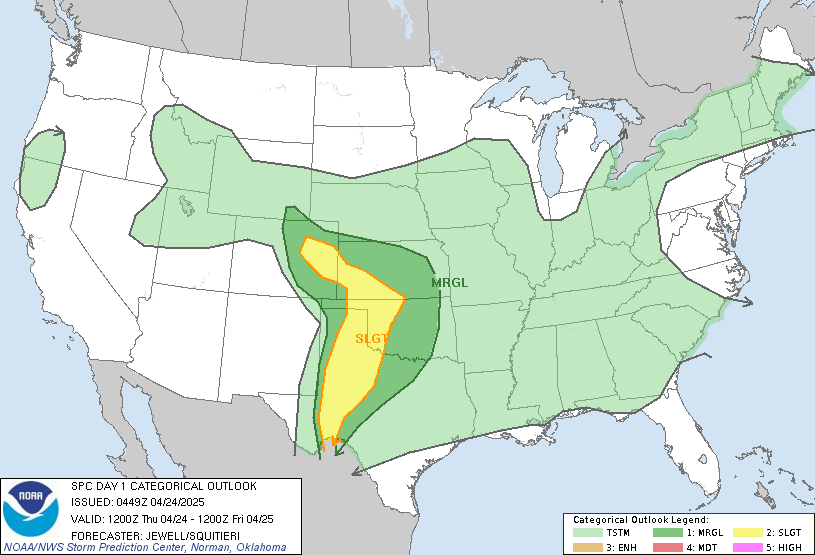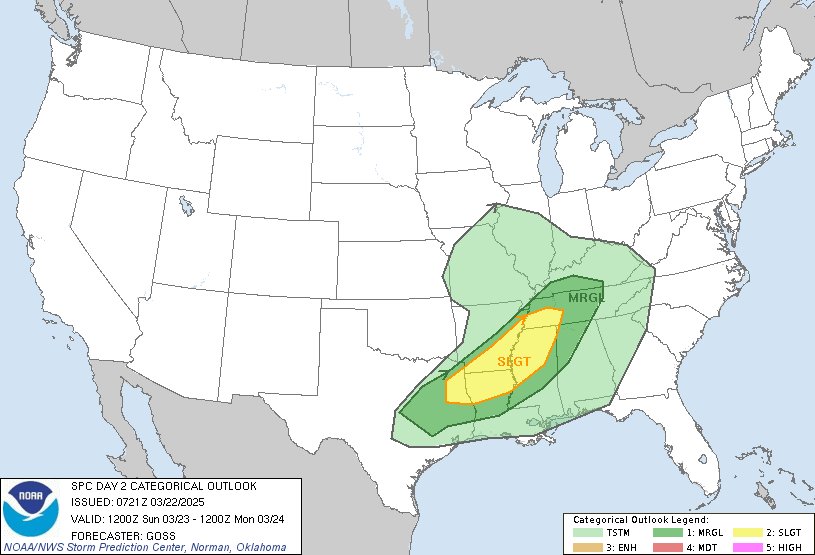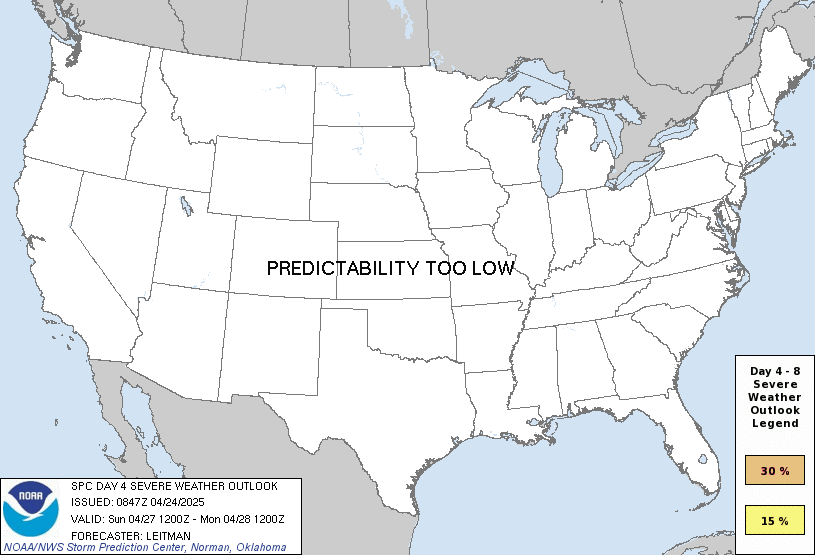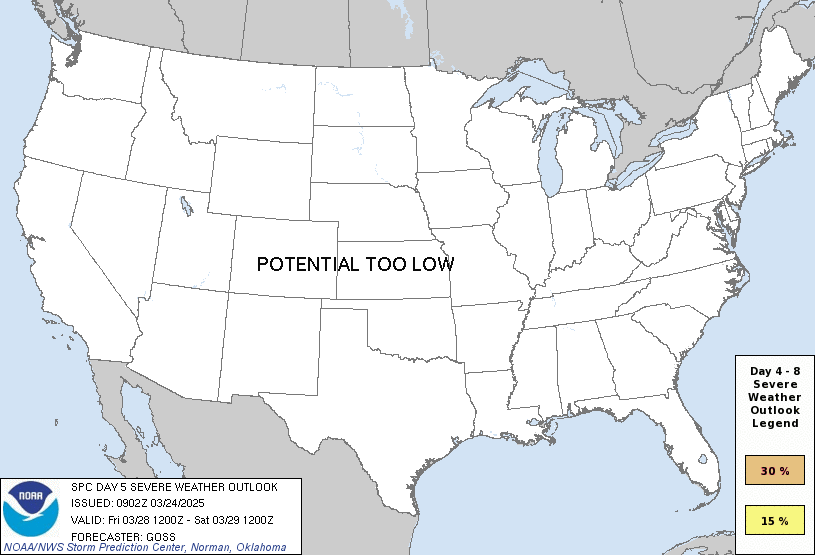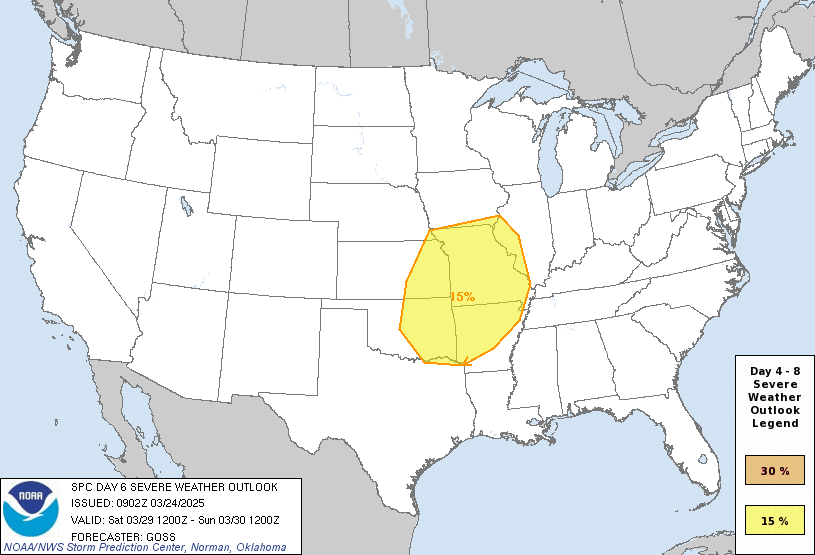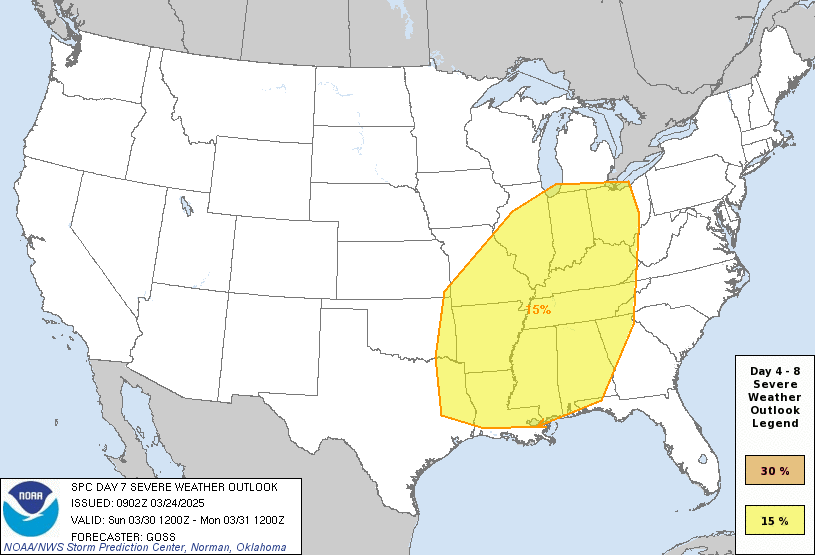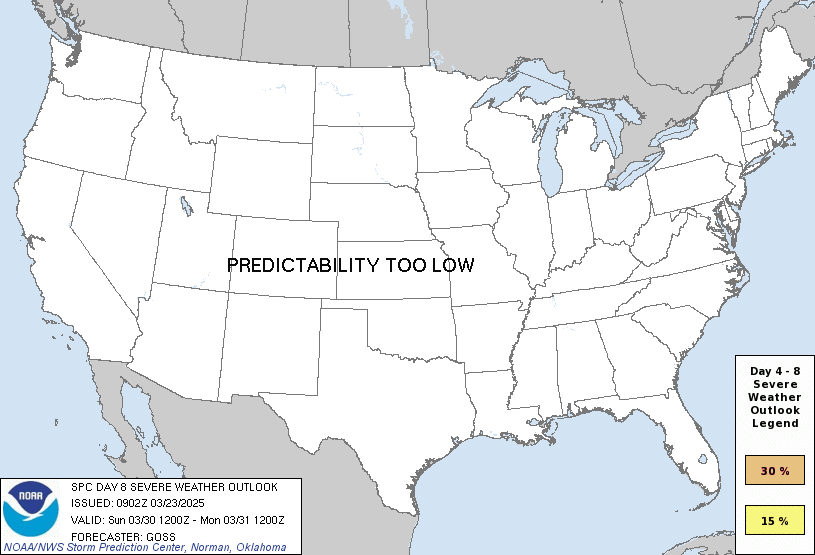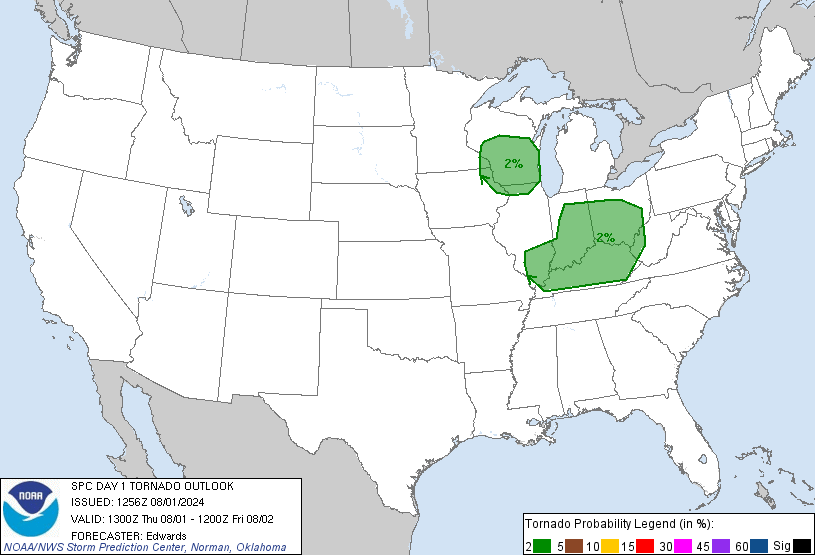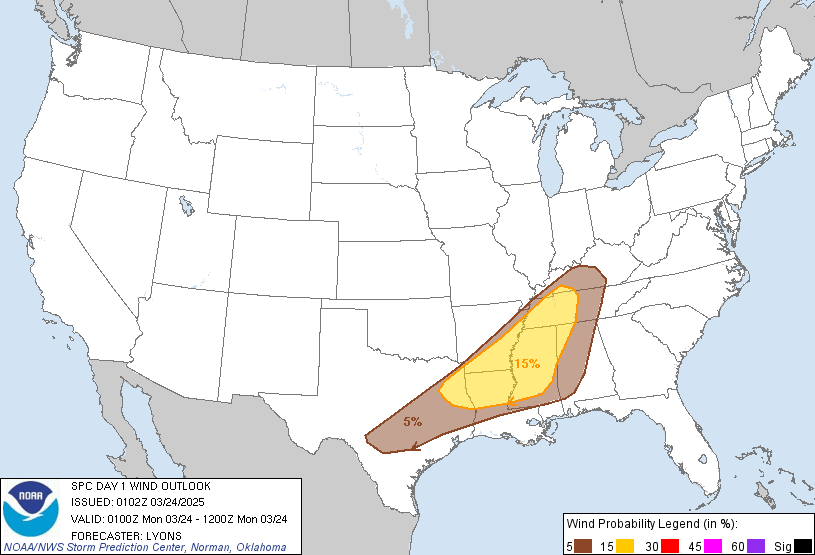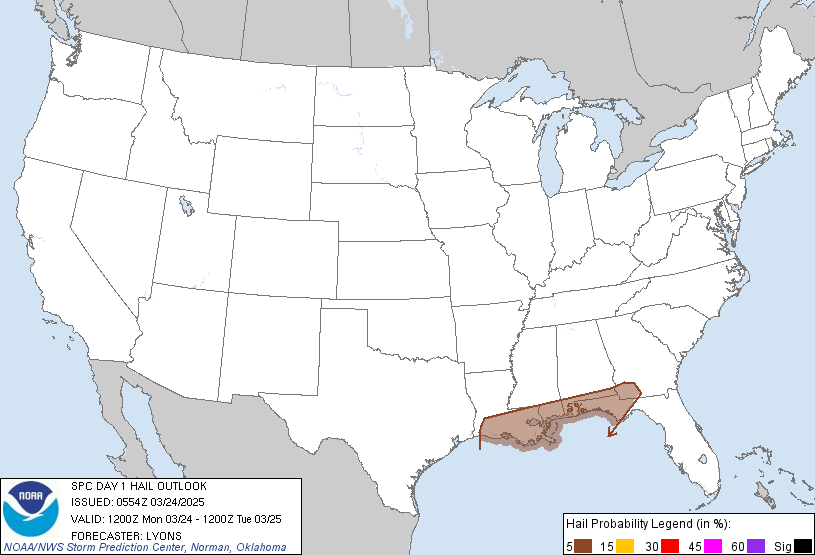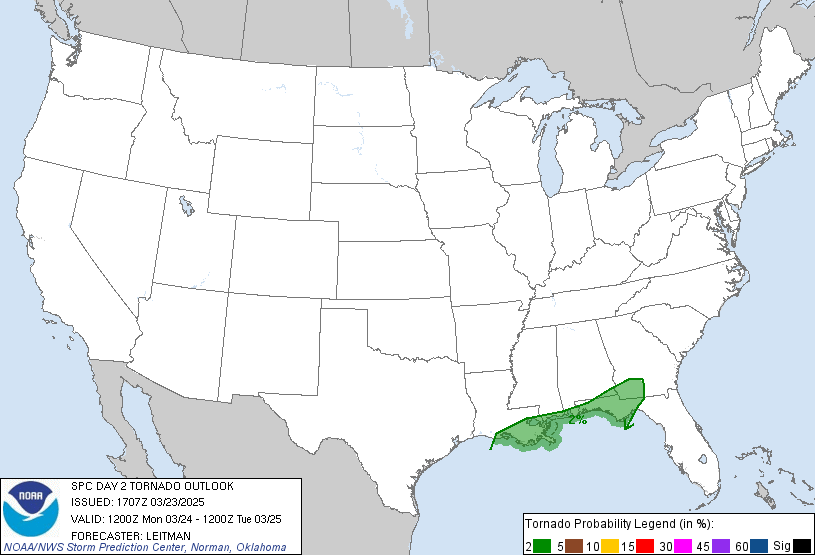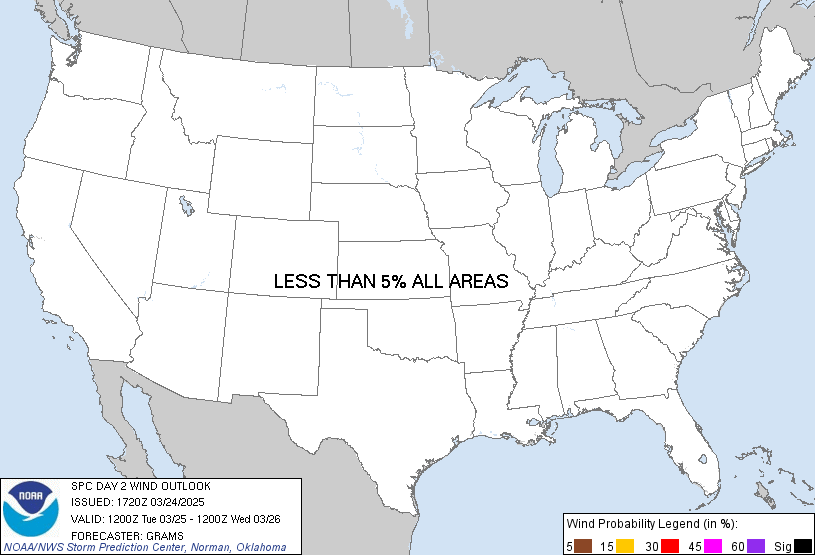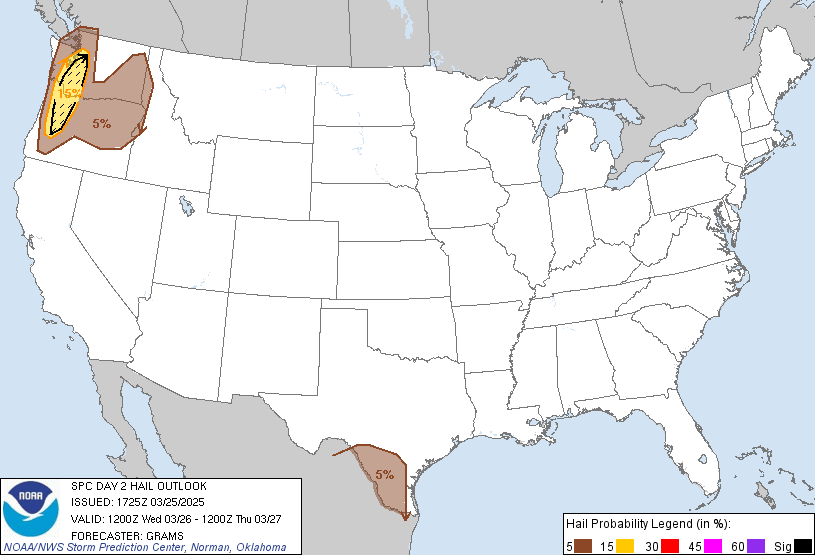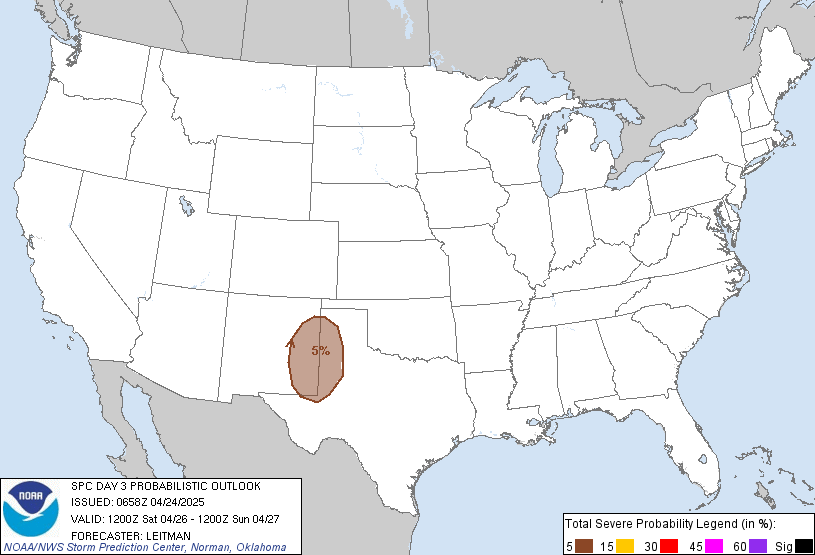Severe Weather Outlook
Hayley here
- Do you like
lofi music
whatever music Hayley put on
and terrifyingly loud computer voices? Then stop by the 24/7 ish severe weather live stream!
* stats delayed and were probably not accurate to begin with
National Severe Weather Outlook for the next week
Here you'll find all available severe weather outlooks on one page.
Overview of the threat for the next few days
Outlook for Saturday, December 20
Outlook Summary
A few lightning flashes may occur late tonight over southern Louisiana; however, this activity will be very sparse.
Outlook Images
Detailed Outlook
← back to overviewSPC AC 210033
Day 1 Convective Outlook NWS Storm Prediction Center Norman OK 0633 PM CST Sat Dec 20 2025
Valid 210100Z - 211200Z
NO SEVERE THUNDERSTORM AREAS FORECAST
### SUMMARY
A few lightning flashes may occur late tonight over southern Louisiana; however, this activity will be very sparse.
01z Update
Weak surface front is expected to settle into northern LA, arcing southwest into the Hill Country of central TX by the end of the period. Favorable low-level trajectories will continue across the western Gulf basin into southern LA tonight where 60s surface dew points are expected to hold. However, large-scale forcing is not expected to be particularly notable and a fairly strong cap is currently noted around 2km on the 00z LCH sounding. Latest model guidance suggests this capping will likely persist, but possibly weaken toward 12z. If so, a few flashes of lightning may accompany weak convection across southern LA.
..Darrow.. 12/21/2025
CLICK TO GET WUUS01 PTSDY1 PRODUCT
NOTE: THE NEXT DAY 1 OUTLOOK IS SCHEDULED BY 0600Z
Outlook for Sunday, December 21
Outlook Summary
Severe thunderstorms are not expected Sunday.
Outlook Images
Detailed Outlook
← back to overviewSPC AC 201704
Day 2 Convective Outlook NWS Storm Prediction Center Norman OK 1104 AM CST Sat Dec 20 2025
Valid 211200Z - 221200Z
NO SEVERE THUNDERSTORM AREAS FORECAST
### SUMMARY
Severe thunderstorms are not expected Sunday.
Synopsis
Zonal flow aloft will become modestly more amplified on Sunday. Upper-level ridging will become more prominent in the central U.S. A low-amplitude shortwave trough will move into the Northwest during the evening. Isolated low-topped thunderstorms may impact coastal areas of Washington and far northwest Oregon. Along the central Gulf coast, a cold front will slow and become nearly stationary inland. A weak warm/moist advection regime could lead to development of showers. Given the slight rise in mid-level heights, residual capping, and lack of greater low-level forcing, potential for thunderstorm development within this regime still appears low.
..Wendt.. 12/20/2025
CLICK TO GET WUUS02 PTSDY2 PRODUCT
NOTE: THE NEXT DAY 2 OUTLOOK IS SCHEDULED BY 0700Z
Outlook for Monday, December 22
Outlook Summary
Severe thunderstorms are not expected on Monday.
Outlook Images
Detailed Outlook
← back to overviewSPC AC 201921
Day 3 Convective Outlook NWS Storm Prediction Center Norman OK 0121 PM CST Sat Dec 20 2025
Valid 221200Z - 231200Z
NO SEVERE THUNDERSTORM AREAS FORECAST
### SUMMARY
Severe thunderstorms are not expected on Monday.
Synopsis
Upper-level ridging will continue across much of the CONUS on Monday. A compact, moderately strong shortwave trough will move into the Pacific Northwest by mid/late afternoon. As the surface high continues to move south and east through the Mid-Atlantic, moisture return will occur in the western/central Gulf Coast regions. Very isolated thunderstorm activity could occur near the Texas Gulf Coast, but this potential should be quite limited given ridging aloft and weak low-level forcing. Within the coastal Northwest, cold temperatures aloft are expected to support isolated, low-topped thunderstorm activity late afternoon into early evening.
..Wendt.. 12/20/2025
CLICK TO GET WUUS03 PTSDY3 PRODUCT
NOTE: THE NEXT DAY 3 OUTLOOK IS SCHEDULED BY 0830Z
Outlook for Tuesday, December 23
Outlook Images
Note on Medium Range Outlooks
You are looking at an outlook that is part of the medium range forecast (the outlook for days 4-8). The most important thing to note is that lack of a risk does not mean zero risk. Generally speaking, confidence has to be pretty high for the Storm Prediction Center to have an outlook area this far into the future.
When no specific risk areas are shown, you might see one of these phrases:
- Predictability Too Low: This means that severe storms might be possible, but forecasters aren't confident enough about where or when they might occur. Think of it as the models showing different possibilities, like pieces of a puzzle that haven't come together yet.
- Potential Too Low: This means forecasters are fairly confident that widespread severe weather is NOT expected on that day. While isolated storms might still occur, the chance of reaching severe criteria across any given area is very low.
If you bookmark this page, it will continue to update with each new outlook that is issued.
Days Covered in this Outlook
| Day 4 | Tuesday, December 23 | potential too low |
| Day 5 | Wednesday, December 24 | predictability too low |
| Day 6 | Thursday, December 25 | predictability too low |
| Day 7 | Friday, December 26 | potential too low |
| Day 8 | Saturday, December 27 | potential too low |
Detailed Outlook
← back to overviewZCZC SPCSWOD48 ALL ACUS48 KWNS 200836 SPC AC 200836
Day 4-8 Convective Outlook NWS Storm Prediction Center Norman OK 0236 AM CST Sat Dec 20 2025
Valid 231200Z - 281200Z
DISCUSSION
The large-scale pattern next week will be highlighted by prominent upper ridging and anomalously high 500-mb heights over much of the central to eastern CONUS, with upper troughing developing toward the West Coast by mid/late week. This pattern should considerably limit deep convective potential over much of the CONUS, even while a relatively warm/moist airmass will exist across the Plains and Midwest.
With the approach of a low-latitude upper trough and increasing moisture, thunderstorm potential, potentially including some strong/locally severe storms with gusty winds, could occur across coastal portions of central and southern California during the last half of Wednesday/Day 5 into Thursday/Day 6 Christmas. However, the degree of destabilization and some synoptic-related forecast details remain uncertain.
..Guyer.. 12/20/2025
CLICK TO GET WUUS48 PTSD48 PRODUCT
Outlook for Wednesday, December 24
Outlook Images
Note on Medium Range Outlooks
You are looking at an outlook that is part of the medium range forecast (the outlook for days 4-8). The most important thing to note is that lack of a risk does not mean zero risk. Generally speaking, confidence has to be pretty high for the Storm Prediction Center to have an outlook area this far into the future.
When no specific risk areas are shown, you might see one of these phrases:
- Predictability Too Low: This means that severe storms might be possible, but forecasters aren't confident enough about where or when they might occur. Think of it as the models showing different possibilities, like pieces of a puzzle that haven't come together yet.
- Potential Too Low: This means forecasters are fairly confident that widespread severe weather is NOT expected on that day. While isolated storms might still occur, the chance of reaching severe criteria across any given area is very low.
If you bookmark this page, it will continue to update with each new outlook that is issued.
Days Covered in this Outlook
| Day 4 | Tuesday, December 23 | potential too low |
| Day 5 | Wednesday, December 24 | predictability too low |
| Day 6 | Thursday, December 25 | predictability too low |
| Day 7 | Friday, December 26 | potential too low |
| Day 8 | Saturday, December 27 | potential too low |
Detailed Outlook
← back to overviewZCZC SPCSWOD48 ALL ACUS48 KWNS 200836 SPC AC 200836
Day 4-8 Convective Outlook NWS Storm Prediction Center Norman OK 0236 AM CST Sat Dec 20 2025
Valid 231200Z - 281200Z
DISCUSSION
The large-scale pattern next week will be highlighted by prominent upper ridging and anomalously high 500-mb heights over much of the central to eastern CONUS, with upper troughing developing toward the West Coast by mid/late week. This pattern should considerably limit deep convective potential over much of the CONUS, even while a relatively warm/moist airmass will exist across the Plains and Midwest.
With the approach of a low-latitude upper trough and increasing moisture, thunderstorm potential, potentially including some strong/locally severe storms with gusty winds, could occur across coastal portions of central and southern California during the last half of Wednesday/Day 5 into Thursday/Day 6 Christmas. However, the degree of destabilization and some synoptic-related forecast details remain uncertain.
..Guyer.. 12/20/2025
CLICK TO GET WUUS48 PTSD48 PRODUCT
Outlook for Thursday, December 25
Outlook Images
Note on Medium Range Outlooks
You are looking at an outlook that is part of the medium range forecast (the outlook for days 4-8). The most important thing to note is that lack of a risk does not mean zero risk. Generally speaking, confidence has to be pretty high for the Storm Prediction Center to have an outlook area this far into the future.
When no specific risk areas are shown, you might see one of these phrases:
- Predictability Too Low: This means that severe storms might be possible, but forecasters aren't confident enough about where or when they might occur. Think of it as the models showing different possibilities, like pieces of a puzzle that haven't come together yet.
- Potential Too Low: This means forecasters are fairly confident that widespread severe weather is NOT expected on that day. While isolated storms might still occur, the chance of reaching severe criteria across any given area is very low.
If you bookmark this page, it will continue to update with each new outlook that is issued.
Days Covered in this Outlook
| Day 4 | Tuesday, December 23 | potential too low |
| Day 5 | Wednesday, December 24 | predictability too low |
| Day 6 | Thursday, December 25 | predictability too low |
| Day 7 | Friday, December 26 | potential too low |
| Day 8 | Saturday, December 27 | potential too low |
Detailed Outlook
← back to overviewZCZC SPCSWOD48 ALL ACUS48 KWNS 200836 SPC AC 200836
Day 4-8 Convective Outlook NWS Storm Prediction Center Norman OK 0236 AM CST Sat Dec 20 2025
Valid 231200Z - 281200Z
DISCUSSION
The large-scale pattern next week will be highlighted by prominent upper ridging and anomalously high 500-mb heights over much of the central to eastern CONUS, with upper troughing developing toward the West Coast by mid/late week. This pattern should considerably limit deep convective potential over much of the CONUS, even while a relatively warm/moist airmass will exist across the Plains and Midwest.
With the approach of a low-latitude upper trough and increasing moisture, thunderstorm potential, potentially including some strong/locally severe storms with gusty winds, could occur across coastal portions of central and southern California during the last half of Wednesday/Day 5 into Thursday/Day 6 Christmas. However, the degree of destabilization and some synoptic-related forecast details remain uncertain.
..Guyer.. 12/20/2025
CLICK TO GET WUUS48 PTSD48 PRODUCT
Outlook for Friday, December 26
Outlook Images
Note on Medium Range Outlooks
You are looking at an outlook that is part of the medium range forecast (the outlook for days 4-8). The most important thing to note is that lack of a risk does not mean zero risk. Generally speaking, confidence has to be pretty high for the Storm Prediction Center to have an outlook area this far into the future.
When no specific risk areas are shown, you might see one of these phrases:
- Predictability Too Low: This means that severe storms might be possible, but forecasters aren't confident enough about where or when they might occur. Think of it as the models showing different possibilities, like pieces of a puzzle that haven't come together yet.
- Potential Too Low: This means forecasters are fairly confident that widespread severe weather is NOT expected on that day. While isolated storms might still occur, the chance of reaching severe criteria across any given area is very low.
If you bookmark this page, it will continue to update with each new outlook that is issued.
Days Covered in this Outlook
| Day 4 | Tuesday, December 23 | potential too low |
| Day 5 | Wednesday, December 24 | predictability too low |
| Day 6 | Thursday, December 25 | predictability too low |
| Day 7 | Friday, December 26 | potential too low |
| Day 8 | Saturday, December 27 | potential too low |
Detailed Outlook
← back to overviewZCZC SPCSWOD48 ALL ACUS48 KWNS 200836 SPC AC 200836
Day 4-8 Convective Outlook NWS Storm Prediction Center Norman OK 0236 AM CST Sat Dec 20 2025
Valid 231200Z - 281200Z
DISCUSSION
The large-scale pattern next week will be highlighted by prominent upper ridging and anomalously high 500-mb heights over much of the central to eastern CONUS, with upper troughing developing toward the West Coast by mid/late week. This pattern should considerably limit deep convective potential over much of the CONUS, even while a relatively warm/moist airmass will exist across the Plains and Midwest.
With the approach of a low-latitude upper trough and increasing moisture, thunderstorm potential, potentially including some strong/locally severe storms with gusty winds, could occur across coastal portions of central and southern California during the last half of Wednesday/Day 5 into Thursday/Day 6 Christmas. However, the degree of destabilization and some synoptic-related forecast details remain uncertain.
..Guyer.. 12/20/2025
CLICK TO GET WUUS48 PTSD48 PRODUCT
Outlook for Saturday, December 27
Outlook Images
Note on Medium Range Outlooks
You are looking at an outlook that is part of the medium range forecast (the outlook for days 4-8). The most important thing to note is that lack of a risk does not mean zero risk. Generally speaking, confidence has to be pretty high for the Storm Prediction Center to have an outlook area this far into the future.
When no specific risk areas are shown, you might see one of these phrases:
- Predictability Too Low: This means that severe storms might be possible, but forecasters aren't confident enough about where or when they might occur. Think of it as the models showing different possibilities, like pieces of a puzzle that haven't come together yet.
- Potential Too Low: This means forecasters are fairly confident that widespread severe weather is NOT expected on that day. While isolated storms might still occur, the chance of reaching severe criteria across any given area is very low.
If you bookmark this page, it will continue to update with each new outlook that is issued.
Days Covered in this Outlook
| Day 4 | Tuesday, December 23 | potential too low |
| Day 5 | Wednesday, December 24 | predictability too low |
| Day 6 | Thursday, December 25 | predictability too low |
| Day 7 | Friday, December 26 | potential too low |
| Day 8 | Saturday, December 27 | potential too low |
Detailed Outlook
← back to overviewZCZC SPCSWOD48 ALL ACUS48 KWNS 200836 SPC AC 200836
Day 4-8 Convective Outlook NWS Storm Prediction Center Norman OK 0236 AM CST Sat Dec 20 2025
Valid 231200Z - 281200Z
DISCUSSION
The large-scale pattern next week will be highlighted by prominent upper ridging and anomalously high 500-mb heights over much of the central to eastern CONUS, with upper troughing developing toward the West Coast by mid/late week. This pattern should considerably limit deep convective potential over much of the CONUS, even while a relatively warm/moist airmass will exist across the Plains and Midwest.
With the approach of a low-latitude upper trough and increasing moisture, thunderstorm potential, potentially including some strong/locally severe storms with gusty winds, could occur across coastal portions of central and southern California during the last half of Wednesday/Day 5 into Thursday/Day 6 Christmas. However, the degree of destabilization and some synoptic-related forecast details remain uncertain.
..Guyer.. 12/20/2025
CLICK TO GET WUUS48 PTSD48 PRODUCT
National Risk Overview
- Saturday, December 20
- TORNADO: low
- HAIL: low
- WIND: low
- Sunday, December 21
- TORNADO: low
- HAIL: low
- WIND: low
- Monday, December 22
- ANY SEVERE: low
- Tuesday, December 23
- ANY SEVERE: potential too low
- Wednesday, December 24
- ANY SEVERE: predictability too low
- Thursday, December 25
- ANY SEVERE: predictability too low
- Friday, December 26
- ANY SEVERE: potential too low
- Saturday, December 27
- ANY SEVERE: potential too low
Your Severe Outlook
Hey, it looks like your location wasn't detected.
Drag the marker on the map and we'll show you the severe weather potential for a given location.
Hi, I'm Hayley. Did you know that I run this site out of my own pocket? So if you'd like to help out and you're already planning on buying something off of Amazon, why not use our Amazon Severe Weather Outlook link before you buy and we'll get a tiny portion of your purchase.
About Severe Weather Outlook . com
SWO started as a spinoff project of wickedwx, but has since replaced the site.
- tornado hq - live severe weather warnings
- cyclocane - hurricanes/typhoons/cyclones
- tornado solitaire - play cards while you monitor the US severe weather threat
- tertremo - live view of earthquakes around the world
- earthquake solitaire - get live earthquake updates as you play your favorite card game


